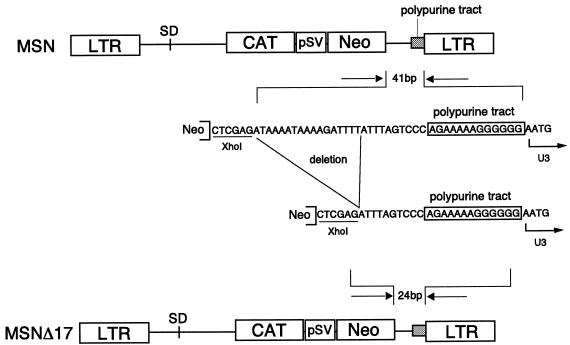FIG. 1.
Schematic representation of retroviral vectors used in this study. MSN contains the nucleotide sequence from the 5′ end of the 5′ LTR to the region right before the start codon of the gag gene. At the 3′ side, MSN has all the nucleotide sequences downstream from the stop codon of the env gene. MSNΔ17 is identical except that it lacks the 17-nucleotide sequence immediately downstream from the stop codon of the env gene. The bacterial CAT sequence was used as a reporter gene and the selectable marker neo is driven by the internal SV40 early promoter. Plasmids used in this study were constructed by PCR using proofreading Pfu DNA polymerase (Stratagene, La Jolla, Calif.). The nucleotide sequences of final constructs were always determined to confirm that there were no mutations introduced by this amplification step. The retroviral vector MSN, which does not have any viral coding sequences, was constructed as follows. pMLV (22) was used for the amplification of the 5′ and 3′ LTR regions. The nucleotide sequences of primers used in amplifying the 5′ LTR region of MLV are as follows (the restriction linkers attached to each primer are underlined): (i) HHIR, AAGCTTATGTGAAAGACCCCTCCTG (the HindIII region is underlined), and (ii) 5LTR3, GGATCCGCGGGCCCACGCGTATTTTCAGACAAATACAGAAAC (the BamHI, SacII, ApaI, and MluI regions are underlined). The amplified product covered the 5′ LTR and 5′ noncoding regions containing packaging signals of MLV. The amplified HindIII-BamHI fragment was cloned into pUC 18, generating p5LTR. To amplify the 3′ LTR region, PCR was performed using primers 3LTR5 and 3LTR3 (3LTR5, GGATCCTCGAGGATAAAATAAAAGATTTTATTTAGTCTCC [the BamHI and XhoI regions are underlined], and 3LTR3, GAATTCAATGAAAGACCCCCGCTGAC [the EcoRI region is underlined]). The amplified product covered the entire 3′ untranslated region downstream from the stop codon of env, containing the polypurine tract and 3′ LTR. The amplified BamHI-EcoRI fragment was then cloned into p5LTR, resulting in pM, retroviral backbone. To insert the SV/Neo cassette into pM, the BamHI-XhoI fragment from pDON-AI (Takara, Shiga, Japan) was inserted into the BamHI-XhoI site of pM, resulting in MSN. To construct MSNΔ17, the 3′ LTR region was amplified using primers M3L52 and 3LTR3 (M3L52, AAAGGATCCATTTAGTCTCC [the BamHI region is underlined], and 3LTR3, GAATTCAATGAAAGACCCCCGCTGAC [the EcoRI region is underlined]). The amplified product covered a 3′ untranslated region 17 bp downstream from the stop codon of env, containing the polypurine tract and 3′ LTR. The amplified BamHI-EcoRI fragment was then cloned in p5LTR, resulting in pMΔ17, retroviral backbone. The BamHI-XhoI fragment from pDON-AI was then inserted into the BamHI-XhoI site of pMΔ17, resulting in MSNΔ17. To construct the retroviral vectors expressing CAT, the BamHI CAT fragment from PCRII-CAT (9) was inserted into the BamHI site of each vector.

